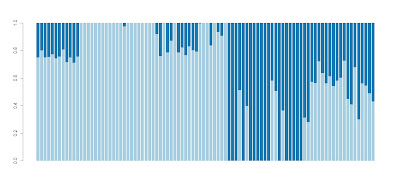 Here are the first two dimensions of a multidimensional scaling in which the following are included:
Here are the first two dimensions of a multidimensional scaling in which the following are included:- Behar et al. (2010) Cypriots, and Ashkenazi/Sephardi Jews
- HGDP-CEPH North Italians and Tuscans
- Dodecad Project Greeks and Part-Greeks (N=7)
- Dodecad Project Italians (N=14)
- Dodecad Project Ashkenazi Jews (N=2)
The Jewish/non-Jewish groups can be distinguished by the first axis, with value greater than 0 including almost all Jews and less than 0 including almost all non-Jews. A group of Sephardic Jews, while still distinguishable, nonetheless approaches the non-Jewish individuals. According to Behar et al. (2010):
Samples from the Bulgarian and Turkish communities were combined in the analysis and are referred to as Sephardi Jews.
 The separability of Ashkenazi Jews from non-Jewish Europeans had been previously reported, e.g., by Tian et al. (2008), from which the figure on the left is presented.
The separability of Ashkenazi Jews from non-Jewish Europeans had been previously reported, e.g., by Tian et al. (2008), from which the figure on the left is presented.The current post adds Sephardic Jews into the picture; these are also distinguishable from non-Jewish Europeans, but appear to be somewhat closer to them -- at least in the first 2 dimensions of an MDS plot.
While the MDS plot gives a nice overview of this distinctiveness, to assess the possible admixture between these various groups, we must turn to ADMIXTURE.
Indeed, there are two groups: dark blue (European Jews), and light blue (Cypriots, Italians, Greeks). I don't want to put too much emphasis on this, as there are obviously many factors at play, e.g., (i) admixture with other elements, not represented in this study (e.g., Spaniards or Anatolians for Sephardi Jews / North-Central Europeans for Ashkenazi Jews / Syrians, or Phoenicians, or Arabs for Southern Europeans), or (ii) inability to detect admixture accurately among closely related groups (the two clusters are at an Fst=0.029); previously I had seen some residual admixture among Tuscans and White Americans
Nonetheless, the ADMIXTURE analysis confirms that (i) non-Jewish Greeks (including Cypriots) and Italians are distinguishable from European Jews, and (ii) Sephardi Jews are closer to these Europeans than Ashkenazi are.
PS: Idea for this post by recent Italianthro post.


From your MDS it seems that better than Italy has had a Greek colonization that Greece has had an Italian one. How do you explain this?
ReplyDeleteEven more Greek language, among the Indo-European ones, is linked with Armenian better than with Western Italic-Germanic-Celtic and separated from the other IE languages very early and formed in Eastern Europe close to the Caucasus and not in Central Western Europe.
Nothing of the sort can be seen in my plot.
ReplyDeleteSo where would I appear in your plot? DOD043, I am not Italian or Greek or Cypriot or Jewish.
ReplyDeleteWhat does it mean "Part-Greeks"? In a genetic analysis including Greeks part-Greek people shouldn't be included (same for other ethnicities). Also it would be better if you separate Italians and Greeks based on broad region (e.g., full Pontic Greek, half Sicilian Italian-half North Italian). I think no participant would feel uncomfortable if you revealed the broad regions as you aren't revealing even the IDs.
ReplyDeletePart Greeks are people whose ancestry is at least 50% in Greece, with the remainder being from a closely related group. As you can see in the MDS plot, Part Greeks in this sense are not really distinguishable from Greeks or some Italians.
ReplyDeleteIn reporting average properties, I will exclude Part Greeks, but there is no harm in including them in this analysis.
Ponto if you are Maltese you wouldn't appear there. Regards.
ReplyDeleteYes I am Maltese, but so. Genetically I am very similar to Southern Italians or Southern Italians are similar to me. The only difference is I am much better looking than any Italian, lol.
ReplyDelete